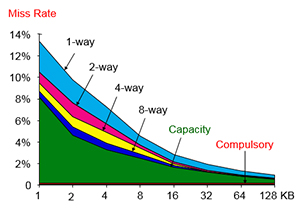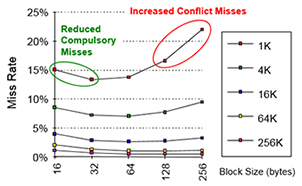The Three Cs (Cont.)
The figures show how the miss rate divides into the three sources: compulsory, capacity, and conflict misses. These sources of misses can be directly attacked by changing some aspect of the cache design.
The following items are observed:
|
 
|
The challenge in designing memory hierarchies is that every change that potentially improves the miss rate can also negatively affect overall performance as shown in the following table:
| Design Change | Effect on Miss Rate | Possible Negative Performance Effect |
|---|---|---|
| Increases cache size. | Decreases capacity misses. | May increase access time. |
| Increases associativity. | Decreases miss rate due to conflict misses. | May increase access time. |
| Increases block size. | Decreases miss rate for a wide range of block sizes due to spatial locality | Increases miss penalty. Very large block could increase miss rate. |